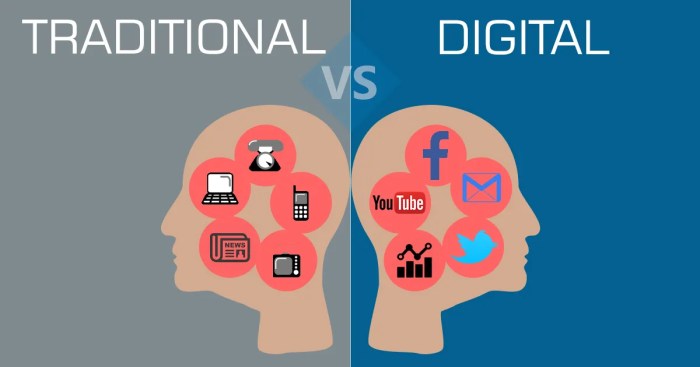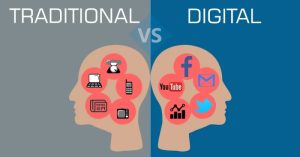
Get ready for an epic showdown between direct marketing and traditional marketing! This battle of the marketing titans will reveal the key differences, strategies, and the pros and cons of each.
As we delve deeper into this clash of marketing methodologies, you’ll uncover the secrets behind effective direct marketing and traditional marketing campaigns.
Direct Marketing vs. Traditional Marketing
Direct marketing and traditional marketing are two distinct approaches to reaching and engaging with customers. Direct marketing involves directly communicating with individuals, while traditional marketing relies on mass media channels to reach a broader audience.
Direct Marketing Strategies
- Personalized emails: Sending tailored messages to customers based on their preferences and purchase history.
- Direct mail: Sending physical promotional materials, such as postcards or catalogs, to targeted recipients.
- Telemarketing: Making phone calls to potential customers to promote products or services.
Traditional Marketing Strategies
- TV commercials: Broadcasting advertisements on television to reach a large audience.
- Print ads: Placing advertisements in newspapers, magazines, or billboards to attract customers’ attention.
- Radio ads: Airing promotional messages on radio stations to reach listeners.
Advantages of Direct Marketing Over Traditional Marketing
- Targeted approach: Direct marketing allows for precise targeting of specific customer segments, leading to higher conversion rates.
- Personalization: Direct marketing enables personalized communication with customers, fostering stronger relationships and brand loyalty.
- Measurable results: Direct marketing campaigns can be easily tracked and measured for effectiveness, allowing for adjustments to improve ROI.
Disadvantages of Direct Marketing Over Traditional Marketing
- Higher costs per contact: Direct marketing can be more expensive per contact compared to traditional mass marketing channels.
- Potential for intrusiveness: Direct marketing efforts, such as telemarketing or unsolicited emails, may be perceived as intrusive by customers.
- Limited reach: Direct marketing may not have the same reach as traditional marketing methods that target a broader audience through mass media.
Marketing E-Commerce
E-commerce has completely revolutionized the way marketing is done in today’s digital age. With the rise of online shopping and digital transactions, businesses have shifted their focus to promoting their products and services through e-commerce platforms. This shift has opened up a whole new world of opportunities for marketers to reach a wider audience and drive sales like never before.
Key Elements in Marketing an E-Commerce Business Effectively
- Website Design and User Experience: A well-designed website that is easy to navigate and offers a seamless user experience is crucial for attracting and retaining customers.
- Search Engine Optimization (): Optimizing your website for search engines can help improve your visibility online and drive organic traffic to your e-commerce store.
- Social Media Marketing: Leveraging social media platforms to promote your products, engage with customers, and drive traffic to your website.
- Email Marketing: Building an email list and sending targeted campaigns to promote new products, offer discounts, and keep customers engaged.
- Content Marketing: Creating valuable and relevant content such as blog posts, videos, and infographics to attract and engage your target audience.
Role of Digital Marketing in Promoting E-Commerce Platforms
Digital marketing plays a crucial role in promoting e-commerce platforms by utilizing various online channels to reach potential customers and drive sales. Some key strategies include:
- Pay-Per-Click (PPC) Advertising: Running targeted ads on search engines and social media platforms to drive traffic and conversions.
- Social Media Advertising: Utilizing platforms like Facebook, Instagram, and LinkedIn to reach a specific audience based on demographics, interests, and behaviors.
- Influencer Marketing: Partnering with influencers to promote your products and reach a larger audience through sponsored content.
- Analytics and Data Tracking: Monitoring key metrics such as website traffic, conversion rates, and customer behavior to optimize marketing campaigns and improve ROI.
Advertising
Advertising plays a crucial role in reaching out to potential customers and promoting products or services. In this section, we will explore the differences between traditional advertising methods and modern digital advertising techniques, the impact of online advertising on consumer behavior, and examples of successful advertising campaigns across different mediums.
Traditional Advertising vs. Digital Advertising
Traditional advertising methods include print ads, television commercials, radio spots, and billboards. These approaches have been used for decades to reach a wide audience. On the other hand, digital advertising techniques leverage online platforms such as social media, search engines, and websites to target specific demographics and track performance metrics in real-time.
- Traditional advertising is often more costly and difficult to measure the effectiveness of the campaign, while digital advertising offers more precise targeting and analytics.
- Online advertising allows for interactive and engaging content, while traditional ads are typically static.
- Digital advertising can be easily adjusted and optimized based on real-time data, unlike traditional methods that require more lead time to make changes.
Impact of Online Advertising on Consumer Behavior
Online advertising has significantly impacted consumer behavior by influencing purchasing decisions and brand perception. The ability to target specific audiences based on demographics, interests, and online behavior has made online ads more personalized and relevant to consumers.
- Retargeting ads, which follow users who have previously visited a website, can remind consumers of products they showed interest in and encourage them to make a purchase.
- Social media advertising allows brands to engage with customers directly, building relationships and fostering brand loyalty.
- Online reviews and user-generated content can influence consumer opinions and purchasing decisions, shaping brand perception in the digital space.
Successful Advertising Campaigns
Several successful advertising campaigns have showcased innovative and creative approaches to reaching target audiences across different mediums. These campaigns have resonated with consumers and achieved significant brand recognition and sales growth.
- The “Share a Coke” campaign by Coca-Cola personalized their bottles with popular names, encouraging customers to find their names and share the experience on social media.
- The “Dumb Ways to Die” campaign by Metro Trains in Australia used a catchy song and animated characters to promote rail safety, going viral and raising awareness about the issue.
- The “Just Do It” campaign by Nike featuring athlete endorsements and motivational messages has become a timeless and iconic advertising strategy that resonates with consumers worldwide.
Affiliate Marketing

Affiliate marketing is a type of performance-based marketing where a business rewards one or more affiliates for each visitor or customer brought by the affiliate’s own marketing efforts. This differs from other marketing strategies as it relies on third-party individuals or companies to promote products or services in exchange for a commission.
Benefits of Affiliate Marketing
- Affiliate marketing can help expand reach and drive more traffic to a business’s website.
- It is a cost-effective way to market products or services as businesses only pay for actual results.
- Affiliate marketing can increase sales and conversions through the efforts of multiple affiliates.
- It allows for better targeting and reaching specific niche audiences through affiliate partnerships.
- Affiliate marketing can improve and overall online presence through backlinks and promotional content.
Tips for Managing an Affiliate Marketing Program
- Choose affiliates carefully by considering their audience, reach, and credibility.
- Provide affiliates with the necessary tools, resources, and support to effectively promote products or services.
- Set clear expectations, goals, and commission structures to motivate affiliates and ensure alignment with business objectives.
- Regularly track and analyze affiliate performance to optimize campaigns, identify top performers, and make data-driven decisions.
- Communicate regularly with affiliates to maintain a positive relationship, address issues promptly, and foster collaboration.
Branding
Branding plays a crucial role in marketing as it helps businesses create a unique identity and build a strong connection with their target audience. The impact of branding on consumer perception can greatly influence purchasing decisions and brand loyalty.
Importance of Branding
Branding is essential for businesses to differentiate themselves from competitors and establish a strong presence in the market. A well-defined brand identity helps in creating trust and credibility among consumers, leading to increased brand recognition and customer loyalty.
- Branding sets businesses apart: By defining what makes a brand unique, businesses can stand out in a crowded market and attract the attention of potential customers.
- Builds trust and credibility: Consistent branding helps in building trust with consumers, as they are more likely to choose a brand they recognize and perceive as reliable.
- Increases brand loyalty: Strong branding fosters customer loyalty and retention, as consumers are more likely to repeat purchases from a brand they trust and resonate with.
Strategies for Building a Strong Brand Identity
Building a strong brand identity requires a strategic approach that involves consistency, authenticity, and effective communication. Here are some strategies to help businesses establish a compelling brand identity:
- Define your brand values and mission: Clearly define what your brand stands for and the values it represents to create a strong foundation for your brand identity.
- Create a unique brand personality: Develop a brand personality that resonates with your target audience and sets you apart from competitors.
- Consistent brand messaging: Ensure that your brand messaging is consistent across all channels to reinforce brand recognition and build trust with consumers.
- Visual identity: Develop a cohesive visual identity, including logos, colors, and design elements, that reflects your brand values and resonates with your target audience.
Impact of Branding on Customer Loyalty and Retention
Branding plays a significant role in influencing customer loyalty and retention. A strong brand identity that resonates with consumers can lead to repeat purchases, positive word-of-mouth referrals, and long-term customer relationships.
“Branding is not just about being seen as better than the competition. It’s about being seen as the only solution to your audience’s problem.”
John Morgan
Direct Marketing
Direct marketing involves reaching out to potential customers directly, without any intermediaries. This approach allows for personalized communication and targeted messaging, making it a valuable tool in the marketing mix.
Channels in Direct Marketing
- Email Marketing: Sending promotional messages directly to a user’s inbox.
- Direct Mail: Sending physical promotional materials, such as brochures or catalogs, via mail.
- Telemarketing: Making direct phone calls to prospects to promote products or services.
- Social Media Marketing: Targeting specific audiences through social media platforms with tailored messages.
Benefits of Personalized Direct Marketing Campaigns
- Increased Engagement: Personalized messages resonate more with recipients, leading to higher engagement rates.
- Improved Conversion Rates: Tailoring offers to individual preferences can boost conversion rates significantly.
- Enhanced Customer Loyalty: Personalized interactions create a stronger bond with customers, leading to increased loyalty.
Examples of Successful Direct Marketing Initiatives
- Amazon’s Personalized Recommendations: Amazon uses customer data to recommend products based on past purchases, browsing history, and preferences.
- Dollar Shave Club’s Subscription Model: Dollar Shave Club sends personalized grooming products to subscribers based on their preferences and needs.
- Starbucks Rewards Program: Starbucks offers personalized rewards and discounts to its loyalty program members based on their purchase history.
Internet Marketing
Internet marketing has revolutionized the way businesses promote their products and services in the digital age. With the increasing reliance on online platforms for information and transactions, internet marketing has become a crucial component of any successful marketing strategy.
Evolution of Internet Marketing
Internet marketing has evolved significantly since its inception. From the early days of banner ads and pop-ups to the sophisticated targeted advertising and personalized marketing campaigns of today, the landscape of internet marketing has undergone a drastic transformation. Businesses now have access to a wide range of tools and techniques to reach their target audience effectively.
Internet Marketing Strategies
- Search Engine Optimization (): involves optimizing your website to rank higher in search engine results pages, increasing visibility and organic traffic.
- Social Media Marketing: Leveraging social media platforms to connect with your audience, build brand awareness, and drive engagement.
- Email Marketing: Utilizing email campaigns to nurture leads, promote products, and build customer relationships.
- Content Marketing: Creating and distributing valuable, relevant content to attract and retain a targeted audience.
Tips for Maximizing Internet Marketing Campaigns
- Define clear goals and objectives for your internet marketing campaigns to measure success effectively.
- Utilize data analytics to track and analyze the performance of your campaigns, optimizing for better results.
- Stay updated on the latest trends and technologies in internet marketing to adapt and stay ahead of the competition.
- Personalize your marketing efforts to cater to the specific needs and preferences of your target audience.
Mailing Lists
Mailing lists play a crucial role in marketing campaigns as they provide a direct line of communication with potential customers. By compiling a list of email addresses or physical addresses of individuals who have expressed interest in a product or service, businesses can effectively target their marketing efforts.
Building a Quality Mailing List
Building and maintaining a quality mailing list is essential for the success of any marketing campaign. Here are some best practices to consider:
- Offer valuable content: Provide incentives such as discounts, exclusive offers, or informative content to encourage people to sign up for your mailing list.
- Use opt-in forms: Ensure that individuals willingly subscribe to your mailing list by using opt-in forms on your website or social media platforms.
- Segment your list: Divide your mailing list based on demographics, interests, or purchase history to send targeted and personalized messages.
- Regularly update and clean your list: Remove inactive subscribers and update contact information to maintain a high-quality list.
- Respect privacy and regulations: Adhere to data protection laws and regulations to build trust with your subscribers.
Leveraging Mailing Lists for Targeted Marketing
Once you have a quality mailing list in place, you can leverage it for targeted marketing efforts:
- Personalize content: Tailor your messages based on subscriber preferences and behavior to increase engagement and conversions.
- Automate campaigns: Use marketing automation tools to send timely and relevant messages to different segments of your mailing list.
- Track performance: Monitor open rates, click-through rates, and conversions to optimize your campaigns and improve results.
- Test and refine: Experiment with different subject lines, content formats, and send times to identify what resonates best with your audience.
Final Review

In the end, whether you’re team direct marketing or team traditional marketing, the key is to understand how each approach can benefit your business. This marketing battle may have winners and losers, but the real victory lies in finding the perfect blend of both strategies for your brand.
Commonly Asked Questions
What is the main difference between direct marketing and traditional marketing?
Direct marketing involves targeting specific individuals or groups with personalized messages, while traditional marketing uses mass media channels to reach a wider audience.
What are some examples of direct marketing strategies?
Direct mail, email marketing, telemarketing, and personalized advertising are all examples of direct marketing strategies.
Why should a business consider using direct marketing over traditional marketing?
Direct marketing allows for precise targeting, personalized communication, and measurable results, making it a cost-effective and efficient marketing approach for many businesses.






